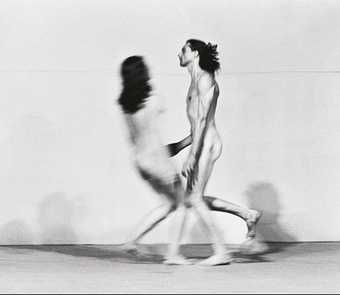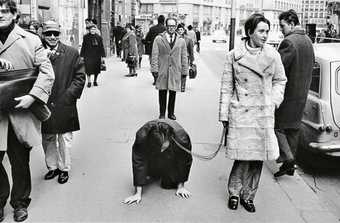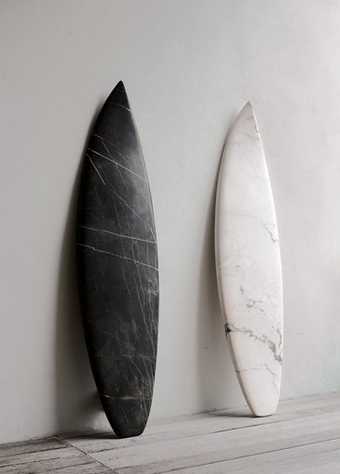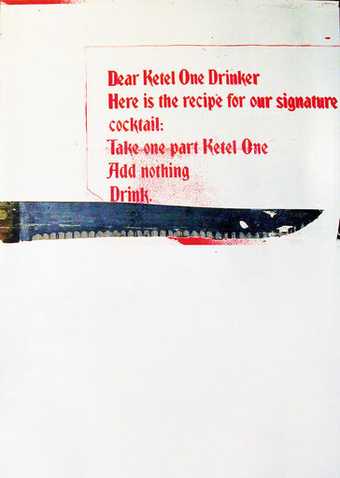A recent exhibition at SculptureCenter in New York with the tongue-in-cheek title, A Voyage of Growth and Discovery, was a collaborative effort between two critically acclaimed mid-career artists, Mike Kelley and Michael Smith. Both have consistently collaborated in the past – Kelley with Paul McCarthy and Tony Oursler, and Smith most recently with young conceptualist Seth Price. So their decision to team up was in keeping with their track record of working with others. Moreover, their years of friendship, coupled with thematic affinities within their work, would seem to portend a natural and fruitful alliance: both have been inclined to root around in the social fabric of society and make explicit the psychological and emotional responses of the individual to cultural mores and pressures. And yet being immersed in A Voyage of Growth and Discovery poses a number of compelling questions about the parameters and processes of such projects. The fact that it is not the product of a singular vision becomes an inextricable component of evaluating and understanding the work. Despite an abundance of varied types of collaborations in the visual arts since early in the twentieth century, this mode of art-making challenges ingrained notions of authorship, originality, ownership and working processes that still dominate our understanding of art. Today, they may rarely be “anti-art” as Dada proclaimed to be early in the twentieth century. But collaboration continues to argue that our field should expand, not contract into modernist heroicism and exclusively object-based practices, and allow for heterogeneity and ingenuity.

Installation view of Mike Kelley and Michael Smith's six-screen video installation A Voyage of Growth and Discovery 2009
Courtesy SculptureCenter, New York, and West of Rome, Los Angeles © the artists
Pondering artistic alliances inevitably begs the question: what, in fact, constitutes a collaboration? How do we differentiate, for example, between a collaboration and a collective? A collective and a movement? Contemporary art practice continues to place enormous value on the individual artist, so what appeal does working together hold? It is apparent that there are many ways to approach collaboration – from the lifetime partnerships of British duo Gilbert & George, to a temporary joining of forces in the shared paintings of Andy Warhol and Jean-Michel Basquiat, which combined Warhol’s silkscreened appropriations with Basquiat’s more expressive graffiti-like scribbles, to shifting collectives whose members change over time, such as the politically-engaged Group Material active in New York City in the 1980s and 1990s – and that the results of these many working methodologies are as varied as the artists themselves.

Performance by Marina Abramovic and Ulay of Relation in Space at the Venice Biennale 1976
Courtesy Sean Kelly Gallery, New York © the artists
Historically, collaborations and artist collectives have, in many cases, grown out of a shared criticism and scepticism of art’s role in society (as a bourgeois indicator of status or simple commodity in the capitalist marketplace, for example) and a desire to break with the conventions of the making, presentation and reception of art. Moreover, these collaborative efforts often reverberated with a political urgency as the practitioners argued for art’s potential to illuminate and participate in the debates surrounding the most volatile and contested issues of the day. Although Dada encompassed a disparate hotchpotch of participants across several cities in Europe and in New York and has convincingly been described as more of an attitude than a movement per se, it was a shared sense of shock and dismay over the violence of the First World War that brought these artists together. Their unified declaration to dismantle bourgeois culture and collective provocations on topics such as nationalism, dislocation and the disasters of war, and their embrace of new technologies and media make them a sort of role model for the radical potential of artistic collaboration.
Launched in 1916 in Zurich, a neutral territory during the war, this international group of artists – working in many media and across disciplines – responded to the chaos and suffering of the war by acting out “total pandemonium”, as Hans Arp called it. Their collaborations varied in terms of the art they produced, resulting in sculpture, photography, performance, film, poetry and collage, much if it uninterested in the expectation that artworks should be characterised by stability and longevity. Despite the deliberate rejection of the autonomous and everlasting art object, numerous fantastic works survive from the various alliances that occurred between the Dadaists. Yet what remains most compelling about these artists is their sense that they could collectively threaten the status quo. Their nihilistic aspiration to tear down the existing paradigm was accompanied by an idealistic belief that they could replace it with a better one.

VALIE EXPORT walks Peter Weibel on a leash in the performance Aus der Mappe der Hundigkeit (From the Portfolio of Doggishness), Vienna, 1968
Courtesy Charin Galerie, Vienna © VALIE EXPORT
Another early example of collaboration that is similarly associated with a movement is the Surrealists’ Exquisite Corpse, a system of creating art specifically designed to accommodate numerous visions. A process that can be applied to writing literature or music, film-making or art, it involves passing the work from one participant to another, each artist building upon the existing imagery (or text, or score) so that the final piece is an accumulation, the outcome of a genuinely shared effort. André Breton, the French writer who founded Surrealism and wrote the Surrealist Manifesto in 1924, notes that the Exquisite Corpse began as a sort of parlour game, but the way in which the process allows for automatism, and its insistence that no single artist can control the end product, is at the very foundation of Surrealism’s tenets and developed as an alternative to the traditions of art-making.
As with the Dadaists, Fluxus in the 1960s was composed of an international group of artists who intentionally worked in multiple media, a methodology dubbed intermedia by one of its founding members, Dick Higgins, in 1966. Several of the early members – George Maciunas, La Monte Young, Jackson Mac Low, Al Hansen, George Brecht, Yoko Ono, Nam June Paik and Higgins – were influenced by composer John Cage’s use of chance and indeterminacy. Their embrace of poetry, performance, happenings and other non-object-based practices was not strictly in resistance to the commodification of art, but rather came out of an abiding interest in co-operation and community. The use of a score, a script, or very simple and brief instructions (a favourite device of Fluxus) to enact an artwork took precedence over the physical object, and the audience became a central component in the work. Allan Kaprow, who orchestrated highly influential performative happenings, sought to blur the distinction between art and life and to shorten the distance between artist and audience. Fluxus created works that had little to do with personal expression or accomplished mastery of medium in favour of those that the audience could easily imagine making themselves or could, indeed, participate in visualising. Al Hansen used discardable materials such as Hershey’s chocolate wrappers and cigarettes to make collages with a distinct relationship to both the body and language. Yoko Ono’s numerous instruction pieces consist of short whimsical texts intended to be enacted by anyone who should so desire. They range from tiny attainable gestures, such as lighting a match and watching it go out, to impossible but poetic actions such as stealing all the clocks and watches in the world and destroying them. Many of Ono’s instructions revolve around imagining or thinking, underscoring the idea that the work of art can exist in the mind alone.
Collaborations – whether they incorporate an entire team of participants across the globe or revolve around a long- standing partnership – evaluate and emulate the construction of identity, recognising the numerous social factors that influence subjectivity and upholding the communal over the individual. While these early examples involve large groups of artists and may be understood more precisely as collectives, the 1970s witnessed the pairing of artists for activities that not only required more than one participant, but were intensely physical investigations into the very nature of collaboration and partnership.
Marina Abramovic and Ulay (Uwe Laysiepen) collaborated on several projects in which their bodies were put into direct contact over long periods of time in order to elicit discomfort or pain, but with the aim of reaching an altered state of mind, one that transcended the limitations of the physical. While their performances may have been rooted in their personal experiences (specifically Abramovic’s adolescence in a repressive post-war Yugoslavia) and could be interpreted as an acting out of the dynamics between the two artists, the vulnerability of their prolonged public encounters also suggested a desire to challenge and connect directly with their audience. In fact, in some works, the audience was deliberately implicated. For Imponderabilia 1977, for example, the nude artists faced each other at the entrance to the museum. Visitors were compelled to squeeze between them in order to gain access to the space, inevitably having to touch their bodies to do so. In an even more extreme example, Tehching Hsieh and Linda Montano spent a year from 1983 to 1984 tied together at the waist by an eight-foot-long rope. Their intention was to break down individuality, to remove their differences, and function as one entity. The performance was extensively documented, so that not only did they have no privacy from one another, they created a situation in which their interactions, their very lives, were continuously open to public scrutiny. While Hsieh and Montano’s collaboration unintentionally exhibited the tensions and struggles that naturally occur between individuals, other performances of this period set out to put fraught power dynamics on public display. In From the Portfolio of Doggishness 1968, VALIE EXPORT guided Peter Weibel around Vienna on a leash like a dog. Vito Acconci’s disturbing video collaboration with Kathy Dillon, Pryings 1971, depicts Acconci unremittingly trying to pry open the eyelids of a resistant Dillon, each person’s rersistence indicative of an increasingly irrational desire to exert their control or maintain their autonomy.
The 1980s witnessed a number of collaborations that were instrumental in changing the contemporary art landscape in New York City and grew out of an engagement with the economic and political climate of the Reagan era. Perhaps the best known of these – General Idea (founded in Toronto in the late 1960s and consisting of AA Bronson, Felix Partz and Jorge Zontal) and Group Material (whose members included Julie Ault, Tim Rollins, Marybeth Nelson, Felix Gonzalez-Torres and Doug Ashford, among others) – seamlessly fused their practices as artists with their commitment to political debate, addressing the urgency of the AIDS crisis, among other issues. Their hugely important work crossed all boundaries and encompassed all media – some pieces simply occurring in the moment and intentionally ephemeral, others now requiring an archivist’s diligence to reconstruct for today’s audiences – and provided compelling examples of art functioning outside commodification and of its ability to rally a community and engage audiences. Comprising both art objects and numerous artefacts, Group Material’s AIDS Timeline 1989 maps out a chronology of the emergence of the disease, the effects of medical and cultural ignorance on its understanding and the United States government’s denial and failure to respond to the crisis.
Art history is full of both committed artist collaborations (often partners, siblings, or close friends) – Gilbert & George, Ed and Nancy Kienholz, Christo and Jean-Claude, the Chapman brothers, Jane and Louise Wilson, Guyton/Walker, Type A (Adam Ames and Andrew Bordwin) – and temporary partnerships that tend to grow out of mutual affection or admiration, such as Warhol and Basquiat’s shared canvases or the mentoring relationship between Brazilian neo-concrete artists Lygia Clark and Hélio Oiticica. Each offers some insight into the benefits and difficulties, the revelations and the pitfalls of working together.

General Idea
Playing Doctor 1992
Chromogenic print
76.2 x 53.3 cm
Courtesy A.A. Bronson © General Idea
Today, there are some fascinating examples of artists approaching collaboration in unusual ways that offer new possibilities. Some of these alliances are, in part, the outcome of a cultural climate that encourages a kind of fractured identity or a response to the overlapping of reality and fiction that increasingly characterises our experiences. While key members of the enigmatic group Bernadette Corporation are known, the collective has managed to remain largely anonymous, enlisting additional participants as needed for any given project and putting forward an analysis of identity as inseparable from corporate messaging and as the stronghold of a now ubiquitous type of branding continuously put into play by contemporary marketing. Bernadette Corporation has organised parties and events, started a fashion label, published a magazine and produced videos and music CDs, among other activities, and, in a work indebted to the Exquisite Corpse model, written a “collective novel” with contributions by twenty collaborators revolving around the fictional persona Reena Spaulings. In a somewhat confusing web of connections, Reena Spaulings also refers to a collaborative named after a fictional artist, performer and dealer. While serving as the moniker for artistic production, an important component of its practice is running a gallery in New York, called, of course, Reena Spaulings Fine Art.

Reena Spaulings
The Belgian Marbles: Marble (Portoro) and Marble (Rosa Portogallo) 2009
Marble sculpture
Each 199 x 51 x 4 cm
Courtesy Sutton Lane Gallery, London/Paris © Reena Spaulings
The Paris-based collective Claire Fontaine, founded in 1994, is also a fictional artistic persona, described by the group as a “readymade artist”. Questioning the role of art as pure commodity and insisting on its responsibility to examine society’s dangerous interweaving of ideas of freedom with violence, the group’s work uses text to send strong messages and urgent queries and borrows the visual language of advertising, nation building and other recognisable systems to express the conflicted desires the marketplace encourages. Collaboratives such as Bernadette Corporation, Claire Fontaine and Reena Spaulings – by creating working methodologies that keep individuality in the shadows and foreground shared input under the rubric of a single entity – revolve around questions of identity to explore, as Claire Fontaine describes, “the crisis of singularity or of the end of authenticity”.
Collaborating with fictional entities is at the heart of the practices of The Atlas Group (Walid Raad) and Mai-Thu Perret, whose multimedia work grows out of her collaborations with an imaginary utopian all-female society. The Atlas Group examines the constant layering of fact and fiction within the powerful realms of the media, political debate and historical documentation or transcription. Taking the history of Lebanon as its subject, its output consists of quasi-documentary elements – photographs, archives, notebooks, video – that comprise the contributions of a number of participants Raad is said to have encountered in his research.

Wade Guyton and Kelley Walker
Untitled (from the series Guyton/Walker: Empire Strikes Back) 2006
Silkscreen and digital inkjet print on canvas
122.2 x 91.4 cm
Courtesy Greene Naftali Gallery, New York © the artists
What is more compelling than trying to analyse and identify where the individual becomes the collective (or vice versa) in practices such as Raad’s or Perret’s is the potential for art these collaborations embody. On the one hand, this approach to art acknowledges how cultural products are inevitably the outcome of numerous existing texts, images and pieces of information. We are a culture that processes enormous amounts of information at rapid speeds. It is as if Roland Barthes’s proclamation of the death of the author and the impossibility of a singular, originary voice has come full circle. Our notions of collaboration within our society are constantly shifting. We see examples of this all around us – from websites that rely on user-generated content to literary works rooted in the tradition of the Exquisite Corpse – and artists will respond to these cultural currents. To understand that the terrain of collaboration has now extended to partnering with fictional entities opens up unknown possibilities, suggesting that artistic collaboration will likely remain one of the most imaginative and radical modes of working for artists in the future.
